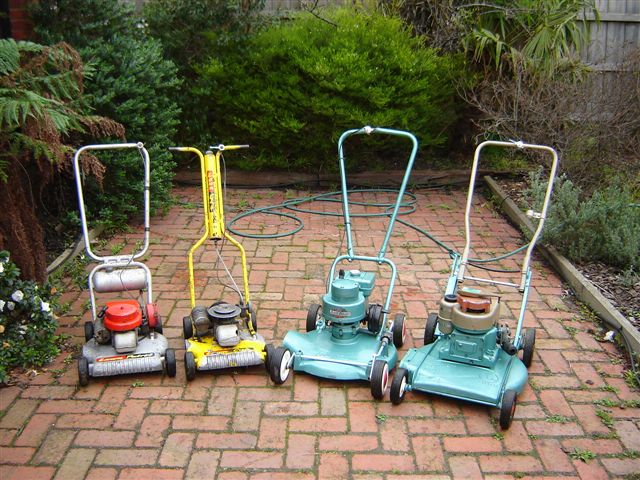On May 18, 1830 an English
textile worker and tinkerer Edwin Beard Budding patented the first mechanical
lawnmower. He based his design on a velvet sheering device at his mill. Blades
mounted on a cylinder rotated as the
machine was pushed sheering grass
against a stationary blade. It could be pushed by a strong man
and also had an auxiliary handle so
it could be pulled by a second.
While functional, his device was cumbersome
and heavy, too expensive for the middling
classes and not worth the investment
by the grand owners of country estates who could rely on
legions of gardeners with scythes and sheep to keep their sweeping lawns under control.
Forty years later American Elwood McGuire patented a simpler, lighter weight reel machine
that could be mass produced and sold
at reasonable prices. By 1885 50,000 push mowers were being sold annually in the United States. This caused a revolution in home
landscaping.
Previously front yards had often been small, weedy and often simply trampled
ground apt to turn seasonally to mud
or dust while back yards were reserved for home
gardens and livestock. Both were typically surrounded by high wooden
fences so the neighbors couldn’t
complain. First front yards, then rear
ones were transformed into lawns in imitation of the estates of the wealthy but on a much more modest scale.
Stockade fences came down to be replaced with picturesque pickets or decorative iron. As long as husbands, sons, or help could be relied on for a couple of
hours a week, middle class women
could enjoy a new feeling of enhanced
status. But lawns in cities, small towns and the emerging suburbs
alike continued to be modest in size
because pushing the mower was still a lot of work.
Enter the back yard tinkerers who spent decades
trying to effectively mount an engine
on the mower. Most tried mounting heavy steam or gasoline powered
motors to existing reel machines.
The
breakthrough came in 1919 when Colonel Edwin George mounted a new light 2-cycle engine perfected during the First World War on a platform
directly driving a rotating blade
spinning parallel to the ground.
Vintage rotary deck power mowers are now a collector's item.
The new power machines did not really catch on in large numbers until the explosion of suburbia after World War II. In fact a good argument can be made that the leap to large lots that characterized the post-war suburban boon would have been impossible without them.
To accommodate ever expanding suburban and exurban
lots, garden tractors with mower
decks and other riding machines grew
steadily in popularity in the late 20th Century. Now they are even seen in much smaller
yards—toys for home owners. And
increasingly lawns of all sizes are now attended to by professional landscapers zipping around on speedy machines that can
turn on a dime.
Now power mowers are a
major source of air pollution in
many areas and modernized push
mowers have made a modest comeback among the ecologically minded and mindless fitness enthusiasts.
But this writer, whose muscles still ache from the memory of doing the quarter acre lot on Cheshire Drive in Cheyenne with a cranky push mower, still uses Col. George’s improvement—and relies on a trusty Granddaughter Caiti and her husband Paul to do the job now that I am officially banned for medical reasons from doing it myself.






I've always wondered about this! I've abandoned lawn as much as possible for natural woodland plants and deep-rooted perennials (the environment thing) but the fresh fragrance of new-mown grass is still a headturner for me! We had lots of it as a kid on a small parcel raising all our own food, plus chickens, pigeons and a fine apple and pear orchard. We kept the grassy spaces mowed to keep back insects and vermin, a threat to the gardens and coops, and of course, us kids. Mu husband and I learned the hard way with our place in Maine that "naturalizing" has its limits, and you really need to have a good swath mowed around the house to guard against insects, mice, squirrels, raccoons and weasels taking up residence in your abode!!
ReplyDelete